This section covers
This section covers
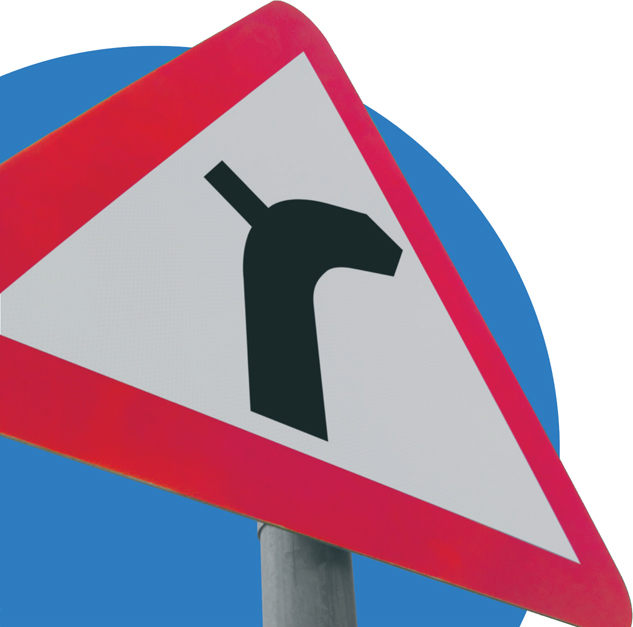
A junction is a point where two or more roads meet. Junctions are hazards where there’s a greater risk of an incident occurring. Treat them with great care, no matter how easy they look.
Look for information about the junction ahead, and the level of difficulty, such as
•the type of junction
•the amount of traffic
•warning signs
•road markings
•direction signs
•‘give way’ and ‘stop’ signs
•traffic lights
•a break in the line of buildings
•changes in road surface.
How you approach a junction depends on what you intend to do. You might want to
•cross a major road going ahead
•join a major road by turning right or left
•leave a major road by turning right or left into a minor road
•stay on a major road and pass the junction.
A major road is one with priority over another at a junction.
Usually, road signs and markings indicate priority. Where no priority is shown at a junction, take extra care.

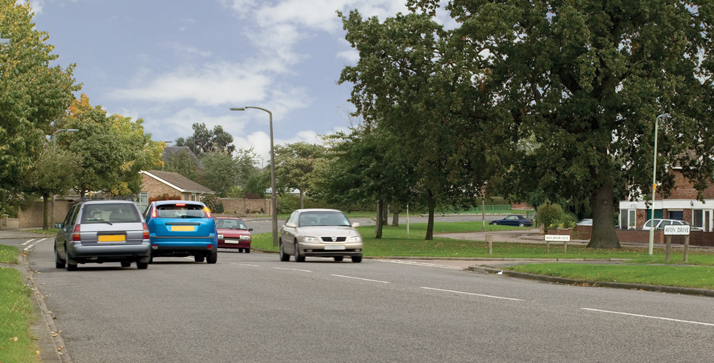
At every junction use the MSM/PSL routine.
M – Check in your mirrors to assess the speed and position of vehicles behind.
S – Signal clearly and in good time.
M –Manoeuvre – use PSL.
P – Position your vehicle correctly and in good time. Early positioning lets other road users know what you’re going to do.
S – Adjust your speed as necessary.
L – Look for other traffic when you reach a point from which you can see.
• Assess the situation.
• Decide to go or wait.
• Act accordingly.
If the road has lane markings
Use the correct lane for the direction you intend to take, and move into it as soon as you can.
Take extra care if your path crosses or joins the path of other road users.
Check your mirrors, particularly for cyclists and motorcyclists, when turning at junctions. They can approach very quickly from behind and are less easy to see than a larger vehicle.
Use the MSM/PSL routine on approach.
Road position Your road position should be well to the left, with the nearside of your vehicle about 1 metre (3 feet) from the kerb.
Speed on approach Left turns into minor roads are often sharper than right turns.
Make sure you
•slow down sufficiently
•select the correct gear
or you could swing wide of the corner and finish up on the wrong side of the road.

Other vehicles Watch out for vehicles
•stopping to park, or parked, just before a left-hand junction
•parked just around the corner
•approaching in the side road.
Pedestrians and cyclists
You should
•give way to pedestrians already crossing when you turn – they have priority
•keep a special lookout for cyclists coming up on your left
•take special care when crossing a cycle track, bus or cycle lane
•hold back and allow a cyclist to clear the junction before you turn, don’t overtake and then cut in on them.
Avoid steering too early or too sharply; a rear wheel might mount the kerb.
After the turn
•If it’s safe to do so, speed up as you leave the junction.
•Check in your mirrors so you know what’s following you on the new road.
•Make sure your signal has cancelled.
Use the MSM/PSL routine on approach.
Road position
•Move into position early when turning right. It helps other drivers.
•Position yourself as close to the centre of the road as is safe, so that vehicles can pass on your left if there’s room. Take into account any parked vehicles or obstructions on the right-hand side of the road.
•In a one-way street move to the right-hand side of the road when appropriate.
Speed of approach
•Adjust your speed as necessary.
•Approach at a safe speed.
Oncoming traffic
•Watch out for oncoming traffic, especially motorcycles and bicycles which are less easily seen.
•Watch particularly for vehicles overtaking oncoming traffic.
•Stop before you turn if you have any doubt about being able to cross safely.
Emerging vehicles
•Watch for vehicles waiting to emerge from the minor road.
Pedestrians
•Give way to pedestrians already crossing the minor road. They have priority.
Obstructions
•Look carefully for anything that could prevent you entering the minor road safely and leave you exposed on the wrong side of the road, risking a serious incident.
•You MUST NOT cross to the other side of the centre line until you’re sure you can enter the minor road safely.
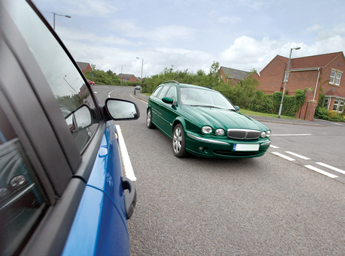
Turning
Check your mirrors for overtaking traffic one final time before you turn. Don’t
•cut the corner
•accelerate fiercely. Your engine should be just pulling as you turn.
Missed turn
If you miss a turning, don’t cause a problem by stopping suddenly. Go past the junction and turn round at the next opportunity.
‘Emerging’ is when a vehicle leaves a minor road to join, cross or turn into a major road.
You’ll have to judge the speed and distance of any traffic on the road you intend to join or cross, and only emerge when it’s safe to do so. This needs care and sometimes patience as well.
Assess the junction. Check road signs and markings and use the MSM/PSL routine.
‘Give way’ sign or lines A ‘give way’ sign and lines across the road means that you must give way to traffic which is already on the road you intend to enter.
If you can emerge without causing drivers or riders on that road to alter speed or course, you can do so without stopping. Otherwise, you must stop.
‘Stop’ sign You must always stop at a ‘stop’ sign, no matter what traffic is like on the road you intend to enter.
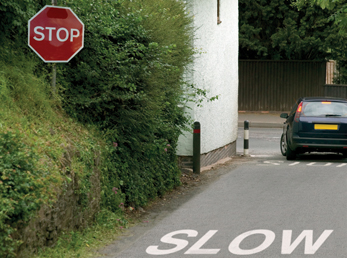
Move off only when
•you have a clear view
•you’re sure it’s safe.
Junctions without signs or road markings
Treat these with great care.
Don’t assume you have priority at an unmarked junction.
MSM/PSL routine
| M – | Look in your mirrors to assess what’s behind. |
| S – | Signal left or right, as appropriate, in good time. |
| M – | Manoeuvre – use PSL. |
| P – | When turning left, keep well to the left, about 1 metre (3 feet) from the kerb. When turning right, position yourself in good time as close to the centre of the road as is safe. In a one-way street move to the right-hand side of the road. |
| S – | Reduce speed. Be prepared to stop; you must give way to traffic on a major road. |
| L – | Look in all directions at the earliest point from which you can see clearly. Keep looking as you slow down or stop, if necessary, until you’re sure it’s safe to enter the major road. |
Bends and hills could make it more difficult to see traffic coming towards you.
If the vehicle approaching from your right is signalling to turn left into your road, wait until you’re sure the vehicle is turning and not just pulling up on the left beyond your road.
Motorcyclists are especially vulnerable at junctions. Look out for them
•coming from behind as you approach the junction
•travelling along the road you’re joining, as they can be very difficult to see.

When to go
You have to decide when to wait and when it’s safe to go. That decision depends largely on your zone of vision.
Your zone of vision is what you can see from your vehicle. It’s determined by
•buildings and hedges
•bends in the road or contours in the land
•moving and parked vehicles
•available light and the weather.
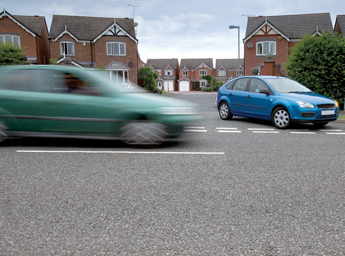
As you approach a junction, your zone of vision on to the other road usually improves. The last few feet are critical.
You can only decide whether to wait or go on when you’ve put yourself in a position where you can see clearly.
Watch out for cyclists, motorcyclists, powered wheelchairs/mobility scooters and pedestrians as they’re not always easy to see.
Sometimes parked vehicles interfere with your zone of vision so that you have to inch carefully forward to see more. If another vehicle or a pedestrian isn’t in your zone of vision, you’re not usually in theirs.
Looking means that you need to assess the situation, decide whether it’s safe and act accordingly.
An approaching vehicle, particularly a bus or a lorry, can easily mask another moving vehicle which may be overtaking.
Watch out particularly for motorcyclists when emerging. They can be especially difficult to see, being smaller than other vehicles but approaching just as fast. They can very easily be masked by another vehicle, especially if they’re overtaking.
After emerging
•Speed up to a safe speed for the road and conditions as soon as possible.
•Use your mirrors to check the speed and position of traffic behind.
•Make sure your indicator is cancelled.
•Keep a safe distance from the vehicle in front.
•Don’t attempt to overtake until you’ve had time to assess the new road.
When turning right, even though there might be little traffic approaching from the right, don’t be tempted to move out and drive down the centre of the road hoping to fit into a gap in the traffic. If the road narrows, or if there are junctions or bollards, you’ll have nowhere to go.
When turning left or right into a major road, it takes time to complete the steering manoeuvre safely.
You need to accurately assess the speed of approaching traffic.
If in doubt, wait!
When you approach a junction
•do so in the correct lane for the direction you intend to take; don’t switch lanes to gain advantage
•look well ahead and watch for traffic and direction signs
•look out for signals from vehicles about to change lanes
•look out for vehicles suddenly changing lanes without signalling.
Articulated or long vehicles Stay clear of large vehicles at junctions. They need much more room than smaller vehicles and may take up a position that seems incorrect to you.
They often swing out to the right before turning left, and to the left before turning right.
Be ready for them to stop if their way is blocked.
Look out for road signs indicating minor roads, even if you’re not turning off.
Watch out for emerging vehicles. Their view is often obscured at junctions. A vehicle might pull out in front of you.
If this happens, and you’re not sure that the driver has seen you, slow down. Be prepared to stop.
Be tolerant and don’t harass the other driver by sounding your horn aggressively or driving too close.
Don’t overtake at, or when approaching, a junction. A left-hand signal from the vehicle in front isn’t an indication for you to pull out and pass.
Always watch out for slippery surfaces or loose chippings. Avoid braking while you’re turning. Plan ahead and brake before the junction.
Adjust your overall speed when passing a series of minor roads so you can stop within the distance you can see to be clear.
There are five main types of junction
•T-junctions
•Y-junctions
•staggered junctions
•crossroads
•roundabouts.
Each type of junction can have many variations.
What you intend to do at the junction determines how you approach each type.
This is where a minor road joins a major road.
Normally the road going straight ahead, along the top of the ‘T’, has priority.
The minor road will either have
•a ‘stop’ sign and road markings
•a ‘give way’ sign and road markings
•‘give way’ lines only
•no road sign or markings.
If you’re emerging from the minor road, follow the procedure on pages 165–167.
Driving on the major road If you want to go straight ahead
•take note of any road signs and markings
•watch out for vehicles emerging to turn left or right
•avoid overtaking any vehicle on the approach to a junction.
Adjust your overall speed when passing a series of side roads on the left. Watch out for vehicles emerging onto the major road.

Hatch markings On busier roads the major road is often split before and after the junction, with a turn-right filter lane protected by white diagonal hatch markings (or chevrons) surrounded by a broken or unbroken white line.
Join and leave the major road at these junctions exactly as you would a dual carriageway.
Areas of hatch markings painted on the road
•separate streams of traffic
•protect traffic waiting to turn right.
Where the boundary line is solid, don’t enter except in an emergency.
Where the boundary line is broken, you shouldn’t drive on these markings unless you can see it’s safe to do so.
Junctions on bends Look well ahead for traffic signs and road markings which indicate priority.
These junctions need extra care, especially when turning right from a major road that bends to the left, because
•your field of vision might be limited
•traffic might be approaching at speed from your left
•you’ll need time to manoeuvre safely.
Your position before you turn mustn’t endanger either oncoming traffic or yourself.
Wait until there’s a gap in the traffic and act positively.
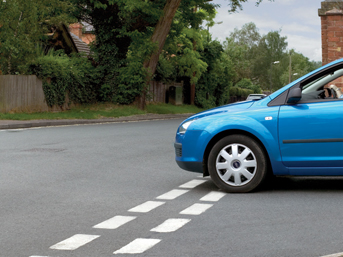
Unmarked junctions Never assume priority over another road if there are no road signs or markings. What’s obvious to you might not be obvious to drivers on the other road.
Watch carefully for vehicles
•approaching the junction on the other road
•waiting at the junction
•emerging from the junction to join or cross your path.
Any vehicle crossing
•might assume priority and expect you to give way
•might not assume priority, but might have misjudged your speed or not seen you.
Such a vehicle creates a hazard. You should respond in a safe and sensible manner. Anticipate and adjust your speed accordingly to avoid a collision.
Y-junctions can be deceptive because they often call for little change in direction.
Normally the road going straight ahead has priority and joining roads have either ‘give way’ or ‘stop’ signs. However, there are many exceptions. Watch out for oncoming vehicles positioned incorrectly. The drivers might have misjudged the junction.
Going straight ahead on the major road
•Look well ahead for road signs and markings.
•Watch out for vehicles emerging to turn left or right.
•You mustn’t overtake when approaching any junction.
Emerging from a minor road If the angle of approach to the major road is very sharp and from the right, the view to your left might be restricted.
If you position your vehicle towards the major road at a right angle as you approach the ‘stop’ or ‘give way’ lines, you’ll improve your view.
This is especially important if your vehicle has no rear side windows – a van, for example.
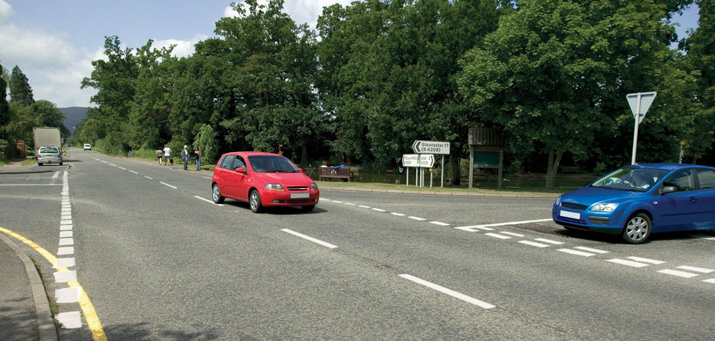
These are junctions where roads join from both the right and the left so that the path from one side road to the other will be staggered.
Driving on the major road Look well ahead for road signs and markings. Use the MSM/PSL routine.
Adjust your speed as necessary and prepare to stop, especially if your view is limited or if another driver’s view of you might be limited.
Watch for vehicles
•emerging from either minor road to turn left or right
•on the major road turning into a minor road on the left or right
•driving across the main road from one minor road into the other.
Emerging When emerging from a minor road to cross the major road and enter the other minor road, watch out for traffic approaching from both directions.
Turning left then right When it’s safe to emerge, drive to the centre of the major road opposite the minor road you intend to enter and check the traffic again before entering the minor road.
If you’re travelling only a short distance from one minor road to another one almost opposite, take extra care and make sure the gap in traffic is wide enough in both directions.
Look, assess, then decide. Either go if it’s safe, or wait.
Crossroads are often road traffic incident black spots, so take extra care, especially on roads carrying fast-moving traffic. Incidents often involve vehicles turning right.
The procedure when turning at crossroads is much the same as at any other junction.
You’ll need to assess the crossroads on approach, so look well ahead and check for road signs and markings which might indicate priority.
Driving on the major road
•Watch for road signs and markings.
•Watch for emerging traffic. Be especially careful of vehicles trying to cut across, using gaps in the traffic. They may misjudge your speed.
•Adjust your speed approaching crossroads.
Turning right Getting your position and speed correct is vital. Look out for traffic on the road you’re joining, as well as on the road you’re leaving.
Check your mirrors before starting to turn, especially if you’ve had to wait.
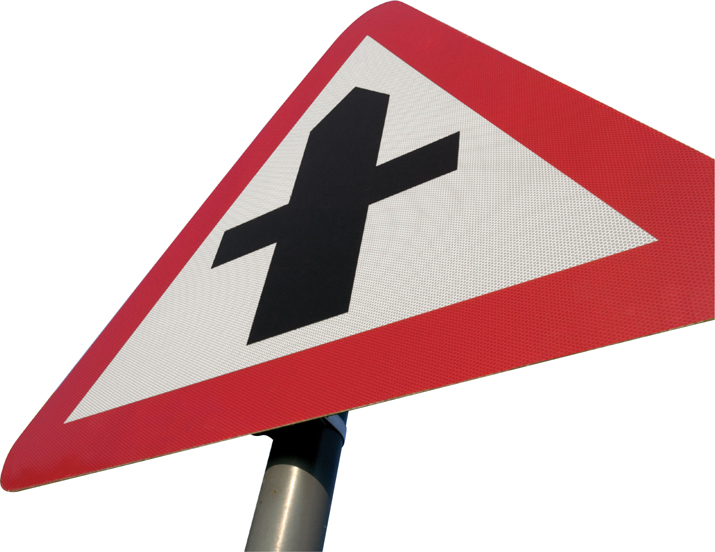
Turning right when an oncoming vehicle is also turning right When two vehicles approaching from opposite directions both want to turn right, there are two methods that can be used. Either method is acceptable, but it will usually be determined by
•the layout of the crossroads
•what course the other driver decides to take
•road markings.
Turning offside to offside
The advantage of this method is that both can see oncoming traffic.
In congested traffic conditions, leave a space for approaching traffic to turn right.
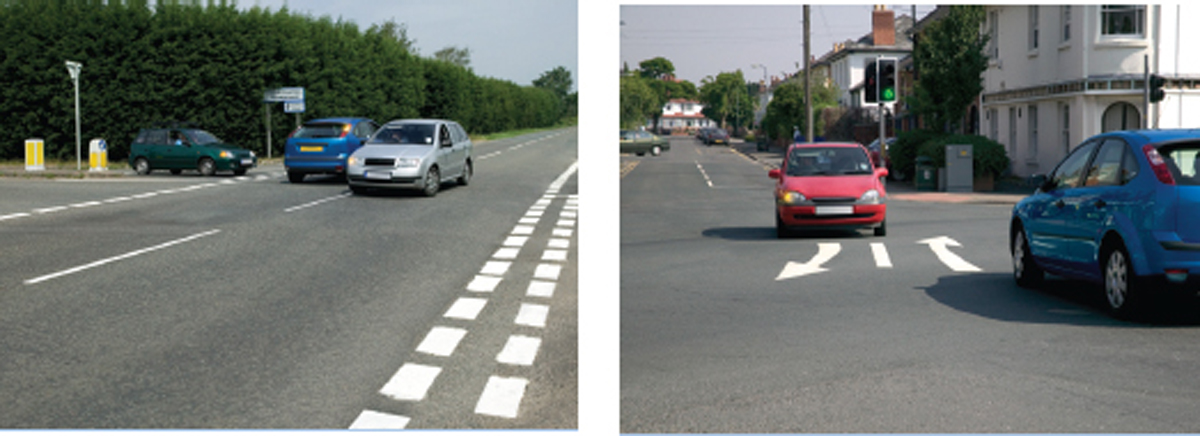
Turning nearside to nearside
This method is less safe because the view of oncoming vehicles isn’t clear. Watch out for oncoming traffic hidden by larger vehicles. Motorcyclists and cyclists are particularly vulnerable as they would be hidden by any type of vehicle.
Be ready to stop for oncoming vehicles.
Police control or road markings sometimes make this method compulsory.
Try to get eye contact with the driver of the approaching vehicle to determine which course is best. Your speed should allow you to stop if the other driver cuts across your path.
Approaching on a minor road If you approach the crossroads on one of the minor roads and want to turn onto the major road, as long as the minor road opposite is clear, you should treat it as if you’re emerging from a T-junction.
If you want to turn onto the major road, and another vehicle is approaching the crossroads from the minor road opposite, then
•if you’re turning left or going straight on, you should proceed with extra caution and make sure no vehicle from the opposite direction is going to cross your path
•if you’re turning right and the other vehicle is going ahead or turning left, you should normally wait for the other vehicle to clear the junction before you make your turn, because you would otherwise be cutting across their path
•if you’re turning right and the other vehicle is turning right, you should try to make eye contact with the other driver to establish who should proceed as neither of you have priority.
Treat unmarked crossroads with extreme caution since neither road has priority. Never assume you have priority if there are no signs or markings.
Drivers approaching on other roads might also assume they have priority, and an incident could result.
Proceed only when you’re sure it’s safe to do so.
Remember LADA – you must Look, Assess and Decide, before you Act.
Take extra care when your view is restricted (by vehicles, walls, hedges, etc).

You may need to take extra care when negotiating junctions on hills.
Downhill junctions
•Getting into the correct position at a safe speed is essential when you’re approaching a downhill junction.
•Make early use of mirrors, signals, brakes, gears and steering to get into position.
•Use the junction routine MSM/PSL. Choose a point with a good all-round view before you look, assess, and decide to go or wait if necessary.
•Oncoming traffic will be climbing more slowly. If you need to cross its path, don’t move from your ‘look’ position until your way is clear.
•Don’t block oncoming traffic and cause a hold-up.
Uphill junctions
Judge your position and speed accurately when climbing towards a junction. Your position is particularly important to drivers following you.
•If you intend to turn right, keep as close to the centre as is safe.
•If you stop in the wrong position you could force drivers behind to stop unnecessarily.
Joining a hill at a junction
It’s relatively easy to judge the speed of vehicles coming uphill.
Turning left at a T-junction into a road where you’ll be driving uphill is reasonably easy. You don’t have to cross traffic and it’s easier to judge the flow of traffic coming uphill.
Turning right at a T-junction into a road where you’ll be driving uphill is more difficult. You have to cross fast-moving traffic coming downhill. At the same time, you have to fit into the flow of traffic coming up from the left without blocking them.
Junctions on dual carriageways
On a dual carriageway, lanes in one direction are separated from lanes in the other direction by a central reservation. There may be a safety barrier along this central reservation.
Some dual carriageways are very similar to motorways, with slip roads to join and leave. However, motorway regulations don’t apply and you may come across slow-moving traffic such as cyclists or farm tractors.
To turn left If there’s no slip road, emerge as you would to turn left into a major road (see page 163). If there’s a slip road, emerge as you would to join a motorway (see section 11).
•Adjust your speed to that of traffic on the main carriageway.
•Look for a gap in traffic and move into the left-hand lane.
•A quick sideways glance might be necessary to check the position of other vehicles (but see page 66).
•Stay in the left-hand lane until you get used to the speed of the traffic in the other lanes.
•Don’t emerge unless you’re sure you won’t cause traffic to alter speed or course.
To turn right You need to cross the first carriageway before you can join the carriageway you want.
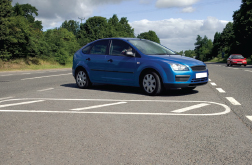
•Assess whether the central reservation is deep enough to protect the full length of your vehicle.
•If the central reservation is deep enough, cross the first carriageway when it’s safe and then wait for a gap in the traffic on the second carriageway.
•If the central reservation can’t contain the length of your vehicle, you mustn’t begin to cross until the dual carriageway is clear in both directions.
•Don’t emerge unless you’re sure you won’t cause traffic on the major road to alter speed or course. This is particularly important if you’re driving a longer vehicle, or towing a caravan or trailer.
Watch out particularly for motorcyclists at these junctions. They can be difficult to see due to their narrow profile and they may be travelling fast on the dual carriageway. They may also be hidden behind slower-moving traffic which they’re overtaking.
After you join the carriageway
•Check your mirrors.
•Cancel any indicator signal.
•Drive in the left-hand lane.
•Accelerate as soon as you can to a suitable and safe speed for the new road.
•Don’t overtake until you’re used to the conditions on the new road.
Always look for signs that might indicate a higher speed limit on the dual carriageway. Allow for this when you assess the speed of oncoming traffic.
Turning left from a dual carriageway
If there’s no slip road, use the same procedure you would for turning left into a side road.
•Use the MSM/PSL routine and get into the left-hand lane in plenty of time.
•Signal left much earlier than you would on ordinary roads because of the higher speeds involved.
•Reduce speed in good time.
If there’s a slip road on the left, use the same procedure as you would for leaving a motorway (see page 236).
Turning right from a dual carriageway
The central reservation sometimes has gaps for turning right. Watch out for special approach lanes.
•Use the MSM/PSL routine.
•Signal right and move into the right-hand lane much earlier than you would on normal roads because of the higher speeds often involved.
•Observe any lane markings.
•Reduce speed in good time.
Take particular care when turning. You might have to cross the path of fast oncoming traffic in two or more lanes. If in doubt, wait.
Roundabouts allow traffic from different roads to merge or cross without necessarily stopping.
Priority Before you enter a roundabout, you normally give way to any traffic approaching from your immediate right. However, you should keep moving if the way is clear.
In a few cases, traffic on the roundabout has to give way to traffic entering. Look out for ‘give way’ signs and road markings on the roundabout.
Some roundabouts have traffic lights (sometimes part-time) which determine priority.
Always use the MSM/PSL routine on approach.
Always look well ahead for the advance warning sign. Especially at large or complex roundabouts this will give you a clear picture of the layout of the roundabout, together with route directions.
The sign will enable you to select the most suitable lane in which to approach the roundabout.
Watch out also for advance warnings of appropriate traffic lanes at the roundabout. These are often backed up by road markings, which usually include route numbers.
•Get into the correct lane in good time.
•Don’t straddle lanes.
•Never change lanes at the last moment.
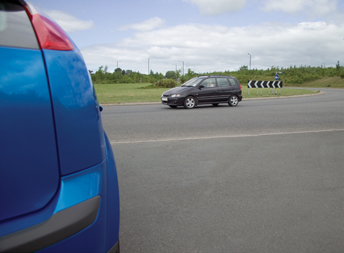
Where possible, it’s a good idea to look across the roundabout and identify the exit you’re aiming to take. This will help you to plan the safest course on the roundabout itself.
Adopt the following procedures unless road signs or markings indicate otherwise.
Going left
•Indicate left as you approach.
•Approach in the left-hand lane.
•Keep to that lane on the roundabout.
•Maintain a left turn signal through the roundabout.
Going ahead
•No signal is necessary on approach.
•Approach in the left-hand lane. If you can’t use the left-hand lane because, for example, it’s blocked, use the next lane to it.
•Keep to the selected lane on the roundabout.
•Check your mirrors, especially the nearside exterior mirror, if one is fitted.
•Indicate left after you’ve passed the exit just before the one you intend to take.
Going right or full-circle
•Indicate right as you approach.
•Approach in the right-hand lane.
•Keep to that lane and maintain the signal on the roundabout.
•Check your mirrors, especially the nearside exterior mirror, if one is fitted.
•Indicate left after you’ve passed the exit just before the one you intend to take.
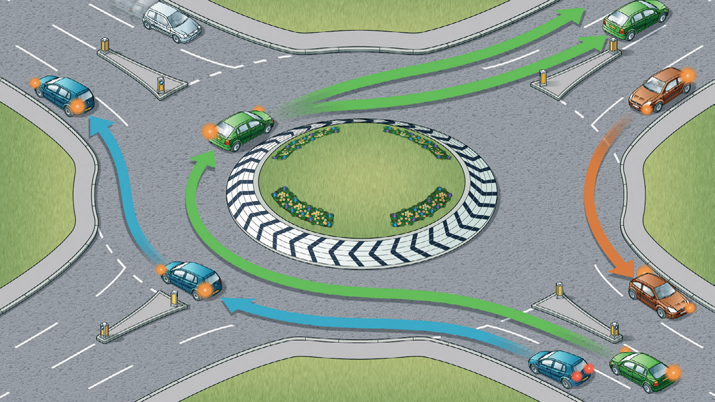
More than three lanes Where there are more than three lanes at the approach to the roundabout, use the most appropriate lane on approach and through the roundabout, unless road signs or markings tell you otherwise.
Remember, when using the right-hand lane to go ahead or turn right, be aware of traffic in the lane to your left.
Always keep an eye on the vehicle in front as you’re about to enter the roundabout.
Don’t assume that the driver will keep going, as they may stop while you’re still looking to the right. Many rear-end collisions happen this way. Make sure the vehicle has actually moved away.
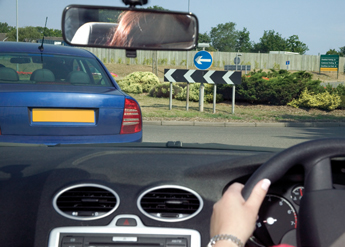
Always check the vehicle in front before moving off.
Hazards Roundabouts can be particularly hazardous areas. While negotiating the roundabout you should be especially aware of
•pedestrians: in many areas, zebra crossings are located near the entrances and exits to roundabouts. Even if there are no formal crossings, pedestrians may attempt to cross the road at these junctions. Always be aware of pedestrians who may be trying to cross the road
•cyclists and horse riders: they often keep to the outside of the roundabout even when intending to turn right. Take extra care and allow them plenty of room
•motorcyclists and cyclists: it’s often difficult to see them on a roundabout
•long vehicles: because of their length, they might take a different course or straddle lanes as they approach the roundabout and as they go round it. Watch out for their signals and allow for the rear of their vehicle cutting in
•all vehicles: be prepared for vehicles to cross your path to leave at the next exit. Always be on the look out for their signals
•the road surface: this can become polished and slippery when wet. Avoid braking and severe acceleration when on the roundabout.
Approach these in the same way as a roundabout: slow down and be prepared to give way to traffic from the right. Remember, however, there’s less space to manoeuvre and less time to signal. For example, there’s often insufficient time to signal left when leaving. Also
•vehicles coming towards you might want to turn right. Give way to them
•be sure any vehicle on the roundabout is going to leave it before you join it
•beware of drivers who are using the roundabout for a U-turn
•you must pass round the central markings unless you’re driving a large vehicle or towing a trailer which is physically incapable of doing so.
Try to avoid using a mini-roundabout to make a U-turn, but be aware that other drivers may do this.
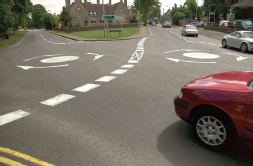
Double mini-roundabouts
•Treat each roundabout separately and give way to traffic from your right.
•Take careful all-round observation before you enter.
At some complex junctions, a large roundabout can incorporate a series of mini-roundabouts at the intersections.
You need to take extra care because traffic can be travelling in both directions around the large roundabout.
Look and assess Keep a good look out and assess the situation at each mini-roundabout. Look for direction signs well in advance.